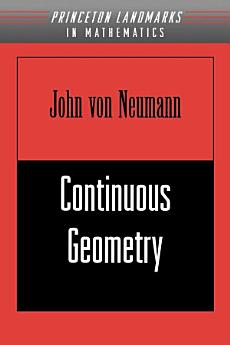Continuous Geometry
มิ.ย. 2016 · Princeton University Press
eBook
312
หน้า
family_home
มีสิทธิ์
info
reportคะแนนและรีวิวไม่ได้รับการตรวจสอบยืนยัน ดูข้อมูลเพิ่มเติม
เกี่ยวกับ eBook เล่มนี้
In his work on rings of operators in Hilbert space, John von Neumann discovered a new mathematical structure that resembled the lattice system Ln. In characterizing its properties, von Neumann founded the field of continuous geometry.
This book, based on von Neumann's lecture notes, begins with the development of the axioms of continuous geometry, dimension theory, and--for the irreducible case--the function D(a). The properties of regular rings are then discussed, and a variety of results are presented for lattices that are continuous geometries, for which irreducibility is not assumed. For students and researchers interested in ring theory or projective geometries, this book is required reading.
This book, based on von Neumann's lecture notes, begins with the development of the axioms of continuous geometry, dimension theory, and--for the irreducible case--the function D(a). The properties of regular rings are then discussed, and a variety of results are presented for lattices that are continuous geometries, for which irreducibility is not assumed. For students and researchers interested in ring theory or projective geometries, this book is required reading.
เกี่ยวกับผู้แต่ง
John von Neumann (1903-1957) was a Permanent Member of the Institute for Advanced Study in Princeton.
ให้คะแนน eBook นี้
แสดงความเห็นของคุณให้เรารับรู้
ข้อมูลในการอ่าน
สมาร์ทโฟนและแท็บเล็ต
ติดตั้งแอป Google Play Books สำหรับ Android และ iPad/iPhone แอปจะซิงค์โดยอัตโนมัติกับบัญชีของคุณ และช่วยให้คุณอ่านแบบออนไลน์หรือออฟไลน์ได้ทุกที่
แล็ปท็อปและคอมพิวเตอร์
คุณฟังหนังสือเสียงที่ซื้อจาก Google Play โดยใช้เว็บเบราว์เซอร์ในคอมพิวเตอร์ได้
eReader และอุปกรณ์อื่นๆ
หากต้องการอ่านบนอุปกรณ์ e-ink เช่น Kobo eReader คุณจะต้องดาวน์โหลดและโอนไฟล์ไปยังอุปกรณ์ของคุณ โปรดทำตามวิธีการอย่างละเอียดในศูนย์ช่วยเหลือเพื่อโอนไฟล์ไปยัง eReader ที่รองรับ







